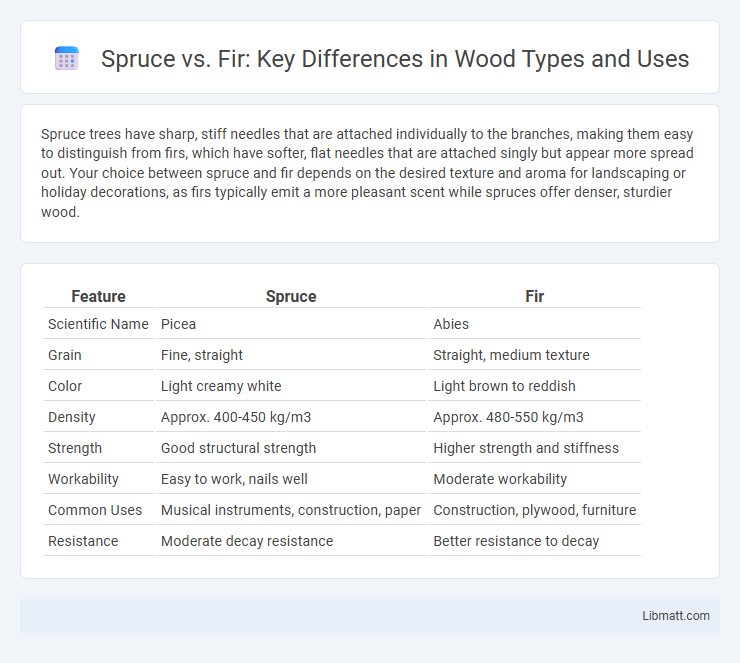Spruce trees have sharp, stiff needles that are attached individually to the branches, making them easy to distinguish from firs, which have softer, flat needles that are attached singly but appear more spread out. Your choice between spruce and fir depends on the desired texture and aroma for landscaping or holiday decorations, as firs typically emit a more pleasant scent while spruces offer denser, sturdier wood.
Table of Comparison
| Feature | Spruce | Fir |
|---|---|---|
| Scientific Name | Picea | Abies |
| Grain | Fine, straight | Straight, medium texture |
| Color | Light creamy white | Light brown to reddish |
| Density | Approx. 400-450 kg/m3 | Approx. 480-550 kg/m3 |
| Strength | Good structural strength | Higher strength and stiffness |
| Workability | Easy to work, nails well | Moderate workability |
| Common Uses | Musical instruments, construction, paper | Construction, plywood, furniture |
| Resistance | Moderate decay resistance | Better resistance to decay |
Introduction to Spruce vs Fir
Spruce and fir are both popular evergreen trees commonly used in landscaping and Christmas decorations, but they differ significantly in needle structure and branch arrangement. Spruce needles are sharp, four-sided, and individually attached to woody pegs, while fir needles are softer, flat, and attached directly to the branch. Understanding these distinctive characteristics helps you choose the right tree for your specific ornamental or functional needs.
Botanical Differences Between Spruce and Fir
Spruce trees belong to the genus Picea and have sharp, four-sided needles attached individually to woody pegs on the branches, while fir trees, from the genus Abies, feature flat, softer needles that are attached directly to the branch without pegs. Spruce cones hang downward and have thin, flexible scales, whereas fir cones stand upright and disintegrate on the tree to release seeds. Understanding these botanical differences helps you accurately identify each species in their natural habitats or landscapes.
Wood Appearance and Grain Comparison
Spruce wood typically features a pale, creamy color with a straight, fine grain that creates a smooth, uniform appearance ideal for soundboards and interior paneling. Fir wood presents a slightly reddish-brown tone with a coarse texture and more pronounced, wavy grain patterns that add character to construction and furniture projects. Your choice between spruce and fir will influence the aesthetic and texture of your woodwork, depending on whether you prefer subtle elegance or a more rustic, pronounced grain.
Growth Habits and Natural Habitat
Spruce trees (genus Picea) typically exhibit a conical shape with dense, upward-pointing branches and thrive in cooler, northern temperate and boreal forests across North America, Europe, and Asia. Fir trees (genus Abies) also display a conical form but have flatter, softer needles and are commonly found in mountainous regions of the Northern Hemisphere, especially in high-altitude or colder climates. Growth habits differ as spruce needles are sharp and four-sided, while fir needles tend to be softer and lie flat, influencing their adaptability to specific environmental conditions within their natural habitats.
Strength and Durability Analysis
Spruce wood is lightweight with moderate strength, making it suitable for construction where flexibility is important, but it is less durable under prolonged exposure to moisture compared to fir. Fir wood offers higher density and superior strength, providing enhanced resistance to wear and structural stress, making it ideal for heavy-duty applications and outdoor use. Both woods require proper treatment for longevity, but fir's natural durability gives it an advantage in long-term performance and load-bearing capacity.
Common Uses in Construction and Carpentry
Spruce is commonly used in construction for framing, decking, and plywood due to its lightweight and strength characteristics. Fir, particularly Douglas fir, is favored in carpentry and structural beams for its durability and resistance to warping. Both woods are popular in cabinetry, flooring, and furniture making, but fir's superior hardness makes it ideal for load-bearing applications.
Workability and Ease of Handling
Spruce offers excellent workability due to its straight grain and fine, even texture, making it easier to cut, shape, and nail without splitting. Fir is slightly denser and tougher, which can require more effort when handling but provides added strength for structural uses. Your choice depends on the balance between ease of handling and the project's durability requirements.
Cost and Availability Comparison
Spruce is generally more affordable and widely available compared to fir, making it a popular choice for construction and woodworking projects. Fir, especially Douglas fir, tends to be pricier due to its superior strength and durability, but it is readily accessible in most North American markets. Both woods are sourced sustainably, yet spruce's abundance in colder climates contributes to its cost-effectiveness and ease of procurement.
Environmental Impact and Sustainability
Spruce trees, commonly used in construction and paper industries, have a faster growth rate compared to fir trees, which can lead to more sustainable harvesting practices when managed properly. Fir trees, often valued for their durability and resistance to decay, typically require longer growth periods, impacting carbon sequestration timelines and forest regeneration rates. Sustainable forestry certifications such as FSC emphasize responsible management of both species to minimize environmental impact and promote biodiversity.
Choosing Between Spruce and Fir: Key Considerations
Choosing between spruce and fir hinges on your specific project needs, as spruce offers a lighter weight and smoother grain ideal for decorative uses, while fir provides greater strength and durability suited for structural applications. Fir's superior resistance to decay and its ability to hold nails well make it a preferred choice for framing and outdoor use, whereas spruce's affordability and ease of staining cater to interior finishes and crafting. Understanding these distinctions ensures you select the wood that best aligns with your functional and aesthetic requirements.
Spruce vs fir Infographic

 libmatt.com
libmatt.com